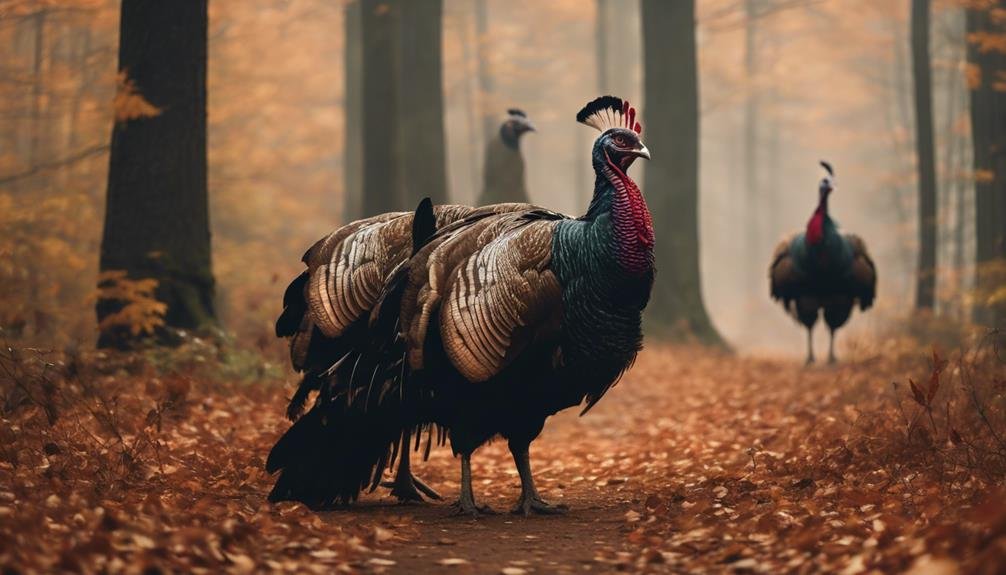Wild turkeys are majestic birds that have evolved to thrive in diverse environments, boasting exceptional sensory capabilities, impressive flight agility, and intelligent adaptability that enables them to navigate their surroundings with remarkable precision. With acute eyesight, acute hearing, and a unique olfactory system, they detect and respond to predators, find food, and navigate their environment with agility and speed. Their remarkable flight capabilities, powered by a pneumatic skeleton and strong muscles, enable them to traverse dense woods and cover distances of over a mile. As we explore the intricate world of turkey titans, we discover the fascinating details of their sensory superpowers, feathered flight machines, and intelligent adaptation.
Key Takeaways
- Wild turkeys possess exceptional eyesight, with a 270-degree field of view, UV light sensitivity, and exceptional color detection.
- Their acute hearing enables them to detect sounds up to 1/200 of a second, allowing them to respond quickly to predators and environment.
- Turkeys have evolved remarkable physical attributes, including a pneumatic skeleton, strong muscles, and aerodynamic feathers, making them agile and efficient flyers.
- With 16% of their body weight consisting of muscle, turkeys can achieve remarkable agility, speed, and power, enabling them to evade predators and traverse dense woods.
- Through conservation efforts, the wild turkey population has rebounded from 30,000 to approximately 7 million birds today, demonstrating the power of collaborative conservation.
Sensory Superpowers
Turkey titans boast an impressive array of sensory superpowers, with exceptional eyesight, acute hearing, and a unique olfactory system that enables them to navigate their environment with remarkable agility and precision. Their visual dominance is characterized by a 270-degree field of view, UV light sensitivity, and exceptional color detection. Sound detection is equally impressive, with the ability to hear faster and more accurately than humans. However, their olfactory system is limited, with underdeveloped olfactory lobes, making them less sensitive to strong smells. Additionally, their taste buds are deficient, restricting their palate to simple tastes like salt, sweet, acid, and bitter. Nevertheless, these sensory superpowers enable turkeys to thrive in their environment, making them formidable creatures.
Feathered Flight Machines
With a unique combination of physical characteristics and abilities, these birds are capable of defying gravity and taking to the skies with impressive agility and precision. Their pneumatic skeleton and strong muscles enable them to generate lift and thrust, while their brilliant feathers play a vital role in flight mechanics. The aerodynamic feathers, with their intricate structure and arrangement, reduce air resistance and enhance lift, allowing turkeys to fly efficiently. By alternating wingbeats and gliding, they can cover distances of over a mile, reaching speeds of up to 50 mph. Their remarkable flight capabilities make them adept at evading predators and traversing through dense woods.
Intelligent Adaptation
Beyond their impressive flight capabilities, wild turkeys have demonstrated a remarkable capacity for intelligent adaptation, evident in their ability to thrive in diverse environments and respond effectively to various predators and challenges. Through evolutionary pressures, they have developed unique survival strategies, such as exceptional eyesight, acute hearing, and specialized feathers. These adaptations enable them to detect and respond to predators, find food, and navigate their surroundings.
| Adaptation | Description |
|---|---|
| Exceptional Eyesight | Turkeys have a 270-degree field of view, with the ability to see in color and detect predators. |
| Acute Hearing | They can hear faster than humans, detecting sounds up to 1/200 of a second, and locate the source of sound. |
| Specialized Feathers | Turkeys have 5,000 feathers, providing insulation, waterproofing, and sensory organ protection, as well as aiding in flight and camouflage.
Conservation Success Story
Through concerted conservation efforts, the wild turkey population has undergone a remarkable resurgence, rebounding from a mere 30,000 individuals in the early 20th century to a thriving population of approximately 7 million birds today. Habitat restoration and the establishment of wildlife corridors have played a vital role in this success story, allowing turkeys to roam freely and maintain ecosystem balance. Conservation ethics have guided these efforts, prioritizing species revival and biodiversity hotspots. The result is a demonstration to the power of collaborative conservation, showing that targeted initiatives can have a profound impact on species recovery. As a keystone species, the wild turkey's resurgence has far-reaching benefits for ecosystem health, underscoring the importance of continued conservation efforts.
Hunting Wild Turkeys
Wild turkeys, now thriving in North American ecosystems, have become a popular game animal, with huntable numbers in every state except Alaska, and a rich cultural heritage surrounding their pursuit. To successfully hunt wild turkeys, hunters must employ effective strategies, such as using realistic turkey decoys and mastering hunting calls. Gear essentials include camouflage clothing, binoculars, and a reliable shotgun. Proper hunt preparation involves scouting, setting up ambushes, and understanding turkey behavior. Hunting ethics emphasize respect for the animal and the environment. Wilderness survival skills, such as navigation and first aid, are also vital.
| Hunting Strategies | Gear Essentials | Hunt Preparation |
|---|---|---|
| Using turkey decoys | Camouflage clothing | Scouting |
| Mastering hunting calls | Binoculars | Setting up ambushes |
| Understanding turkey behavior | Reliable shotgun | Understanding turkey behavior |
Turkey Senses and Abilities
With their exceptional sensory abilities, turkeys have evolved to thrive in their environment, possessing remarkable visual, auditory, and physical attributes that enable them to detect and respond to predators, find food, and navigate their surroundings.
Their visual acuity is impressive, with a field of view of 270 degrees and the ability to see in the UV light range. Turkeys also possess whisker sensitivity, which aids in detecting subtle changes in their environment.
Here are three key aspects of a turkey's senses:
- Exceptional Vision: Turkeys have three times greater visual acuity than humans with 20/20 vision.
- Acute Hearing: Turkeys can hear faster than humans, detecting sounds up to 1/200 of a second.
- Sensitive Whiskers: Turkeys use their whiskers to detect subtle changes in air pressure, temperature, and humidity, aiding in predator detection and navigation.
Strong Yet Agile Bodies
Sixteen percent of a turkey's body weight is comprised of muscle, which, combined with their pneumatic skeleton, enables them to defy gravity and achieve remarkable agility. This unique body composition allows turkeys to exhibit exceptional Body Mechanics, facilitating their remarkable Power Stride. Their powerful legs, packed with thigh muscle mass, enable them to cover great distances at speeds of up to 25 mph. Additionally, their pneumatic skeleton reduces their overall weight, allowing for efficient energy expenditure. This remarkable combination of strength and agility enables turkeys to navigate dense woods with ease, making them formidable creatures in their natural habitat. Their impressive physical characteristics have evolved to promote their survival and thrival in the wild.
Unique Communication Methods
Turkeys possess a sophisticated vocal repertoire, comprising 29 distinct calls that facilitate complex communication and social interaction among individuals. This unique communication system allows them to convey information about food, predators, and social status.
- Flock dialects: Turkeys develop distinct vocal patterns within their flocks, which helps maintain social bonds and identify individual members.
- Vocal hierarchies: Dominant birds use specific calls to assert their dominance, while subordinate birds respond with submissive vocalizations.
- Call patterns: Turkeys have specific call patterns for different situations, such as alarm calls for predators or social chirps for flock reunions.
This complex communication system is a demonstration of the remarkable social intelligence of wild turkeys, allowing them to thrive in their environments.
Camouflage and Insulation
Beyond their impressive vocal repertoire, turkeys have evolved sophisticated physical adaptations that enable them to thrive in their environments, including remarkable camouflage and insulation capabilities. Their feathers, numbering over 5,000, play a vital role in thermal regulation, providing excellent insulation and waterproofing. Feather maintenance is essential, and turkeys achieve this through practices like dusting, which removes excess oil and keeps their feathers in top condition. This unique adaptation also allows them to blend in with their surroundings, making them expertly camouflaged. Additionally, their feathers serve as a sensory organ, providing protection and aiding in their overall survival. By mastering the art of camouflage and insulation, turkeys have successfully adapted to their environments, ensuring their survival in the wild.
Swift Legs and Sharp Eyes
Frequently, the swift legs and sharp eyes of turkeys work in tandem to facilitate their remarkable elusiveness and agility, allowing them to swiftly respond to predators and navigate their environment with ease. This synergy enables them to execute Fast Pursuit, rapidly fleeing from threats with their powerful legs, which can reach speeds of up to 25 mph.
Additionally, their exceptional Visual Dominance is attributed to their remarkable eyesight, which is three times greater than that of humans with 20/20 vision. This allows them to detect even the slightest movements and spot potential threats from a distance.
Some key aspects of their visual and physical abilities include:
- 270-degree field of view, allowing them to detect predators from the side and rear.
- Ability to rotate their neck and bob their head to take in a full 360-degree view.
- Exceptional hearing abilities, which supplement their vision and aid in their elusiveness.
From Near Extinction
Historically, the wild turkey population had dwindled to a mere 30,000 individuals in North America, a drastic decline that threatened the very survival of the species. Habitat destruction and overhunting led to this alarming decline. However, concerted conservation efforts, including habitat preservation and species revival initiatives, have played a vital role in the remarkable recovery of the wild turkey population. The National Wild Turkey Federation's efforts have been instrumental in reintroducing and restocking wild turkeys in various habitats. These initiatives have not only helped to increase the population but have also contributed to the species' revival. Today, wild turkeys can be found in every state except Alaska, with an estimated population of around 7 million.
Reintroduction and Recovery
Through a concerted effort of reintroduction and restocking programs, wild turkey populations have made a remarkable recovery, with the National Wild Turkey Federation playing a pivotal role in this conservation success story. The federation's efforts have led to the establishment of wildlife corridors, allowing turkeys to roam freely and connect fragmented habitats. Additionally, habitat restoration projects have revitalized habitats, providing turkeys with essential food and shelter.
- Habitat restoration projects have increased food sources and shelter for turkeys.
- Wildlife corridors have connected fragmented habitats, allowing turkeys to roam freely.
- Reintroduction programs have led to the re-establishment of sustainable turkey populations.
These conservation efforts have contributed substantially to the recovery of wild turkey populations, ensuring their continued thrival in North America.
Turkey Hunting Essentials
Turkey hunting requires a combination of skill, strategy, and knowledge of wild turkey behavior, making it a challenging yet rewarding pursuit for enthusiasts. Successful turkey hunting involves understanding the bird's behavior, including its keen senses, intelligence, and adaptability. Hunters must employ effective hunting strategies, such as calling, decoying, and stalking, to outsmart their quarry. Gear essentials include high-quality optics, camouflage clothing, and reliable firearms or archery equipment. A well-planned hunting strategy, combined with the right gear, can substantially increase the chances of a successful harvest. By understanding wild turkey behavior and employing effective hunting strategies, enthusiasts can experience the thrill of the hunt and bring home a prized trophy.
Community and Resources
A thorough network of resources and online forums, such as the MeatEater community, serves as a vital hub for turkey hunting enthusiasts to share knowledge, exchange strategies, and access specialized gear and equipment. This community provides a platform for turkey hunters to connect, learn, and grow together.
- Turkey mentorship programs pair experienced hunters with novices, fostering knowledge transfer and skill development.
- Hunting forums and online communities, such as Reddit's r/turkeyhunting, offer a space for discussion, Q&A, and resource sharing.
- Wildlife podcasts, like the Turkey Talk Now podcast, feature expert interviews, gear reviews, and hunting tips, further enriching the community.
Wild Turkey Subspecies
Five distinct subspecies of wild turkeys, each with unique characteristics and habits, have been identified across North America. The Eastern Wild Turkey, found in the eastern United States, inhabits deciduous forests with dense undergrowth. The Osceola Wild Turkey, native to Florida, prefers scrub habitats with palmetto and oak trees. The Rio Grande Wild Turkey, found in the southwestern United States, occupies arid regions with mesquite and cacti. The Merriam's Wild Turkey, inhabiting the western United States, favors mountainous regions with coniferous forests. The Gould's Wild Turkey, found in the southwestern United States and Mexico, occupies desert habitats with scrubby vegetation. These subspecies exhibit genetic variations, regional adaptations, and species distinctions, reflecting their unique habitat preferences and characteristics.
Frequently Asked Questions
Can Turkeys See in Complete Darkness?
Turkeys' exceptional eye structure, featuring seven types of photoreceptors and six types of cones, allows them to see in low light conditions, but not in complete darkness, as they lack nocturnal adaptations for absolute darkness.
Are Domesticated Turkeys as Intelligent as Wild Ones?
Notably, wild turkeys can recognize individual faces for up to 3 years. Domesticated turkeys, lacking Flock Dynamics and Social Learning opportunities, exhibit reduced cognitive abilities compared to their wild counterparts, with diminished problem-solving and communication skills.
Can Turkeys Swim and if So, How Well?
Turkeys, possessing waterfowl adaptations, can swim efficiently, utilizing their feather maintenance habits to maintain buoyancy. Their dense, water-repellent feathers and strong legs enable them to propel through water with ease, making them capable swimmers.
Do Turkeys Have a Natural Alarm Call for Predators?
Turkeys employ a sophisticated communication system, utilizing specific vocalizations to convey predator alerts, including a distinctive 'putt' or 'chirp' to warn their flock of potential threats, thereby triggering a swift and coordinated response to guarantee collective safety.
Can Turkeys Be Kept as Pets and if So, What Care Is Required?
Turkeys can be kept as pets, but require specific care, including secure fencing requirements to prevent escape and predation, and a varied diet that includes grains, fruits, and vegetables to promote excellent health and well-being.
Conclusion
In summary, the remarkable sensory abilities, physical characteristics, and intelligent behaviors of wild turkeys have enabled them to thrive in their environments. Significantly, the species has experienced a significant population increase, with a 200% growth rate over the past 30 years. This remarkable recovery is a tribute to effective conservation efforts. As a result, wild turkeys have become an essential part of their ecosystems, playing a crucial role in maintaining ecological balance.









